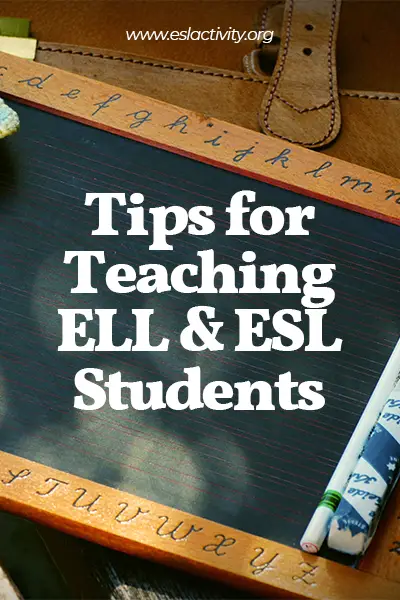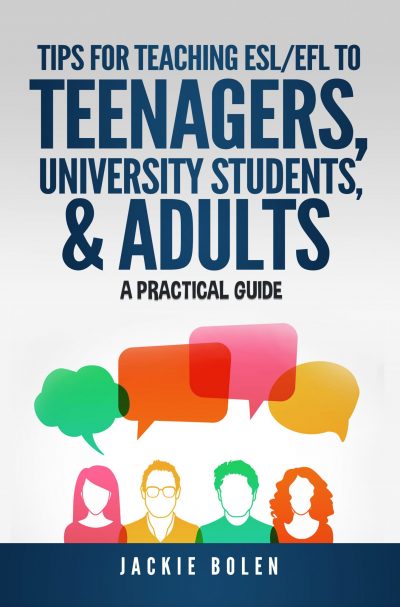Are you an ELL (English Language Learner) teacher searching for ESL teaching strategies? If you’re looking to level up your English teaching, then you’re certainly in the right place. There are a ton of tips for teaching English language learners that are going to help make you a better teacher, and of course, your students will be happier too!
Tips for Teaching English to ELL and ESL
Tips for Teaching ESL/EFL to Teenagers, University Students and Adults is a very practical guide for English teachers. It’s available on Amazon in both digital and print formats. Consider keeping a copy on the bookshelf in your office and using it as a handy reference guide. Or, take the digital copy with you on the go and get a serious dose of inspiration while commuting to work or at your favourite coffee shop. Yes, it really is that easy to have better English classes!
What about the Author?
The author, Jackie Bolen has more than 15 years of experience teaching English in South Korea and in Canada. She’s taught the very basics to far more advanced things like academic writing, English proficiency test preparation, and public speaking. Combine that with her Celta and Delta certifications, and she is well-qualified to offer advice and tips to English teachers.

Tips for Teaching ELL & ESL Students
What Can I Find in this Tips for Teaching English Book?
Of course, you probably want to know what’s in the book before dropping some cash, right? You can find tips related to the following categories:
- General teaching tips
- English teacher mistakes
- Classroom management strategies
- ESL lesson planning tips
- Tips for teaching teenage or adults beginners
- Tips for avoiding English teacher burnout
- Teaching speaking
- Listening instruction
- Teaching writing
- Teaching reading
- Grammar teaching
And more! There are a ton of tips to cover the whole range of English teaching experiences. It’s ideal for newbies who are just getting started on their English teacher journey, or veterans who need a fresh dose of inspiration. There certainly is something for everyone and it’s the most practical English teachers’ guide available today.

How to Teach English Language Learners
- Bolen, Jackie (Author)
- English (Publication Language)
- 120 Pages - 02/24/2020 (Publication Date) - Independently published (Publisher)
Where Can I Get the Book?
If this sounds exactly like what you might need for your teaching journey, then head on over to Amazon to learn more about it. The book is available in print and digital formats, so it’s easier than ever to get the inspiration and practical help you might need. Check out the book for yourself today:
FAQs About ESL Teaching Strategies
Here are some of the most frequently asked questions about ELL teachers and tips for teaching English to ELL students.
What is an ELL student?
An ELL student means a student learning the English language whose primary language is not English. ELL students, therefore, need language support to improve their English skills.
What do ELL students struggle with?
ESL and ELL students struggle academically in many areas: speaking, writing, listening, and reading. It is challenging to learn another language; it is why ELL students search for academic support from ESL teachers. Generally, many students struggle with speaking fluently in English.
Tips for teaching English to ELL and ESL students
More ELL Tips
Here are 10 tips for teaching English Language Learners (ELL):
Create a welcoming and inclusive classroom environment
Foster a supportive and accepting atmosphere where ELL students feel comfortable expressing themselves and taking risks with their language skills.
Use visual aids and gestures
Supplement your verbal instructions with visual aids, such as pictures, charts, and diagrams. Incorporate gestures and body language to enhance understanding and reinforce key concepts.
Simplify and clarify language
Use clear, simple language when explaining concepts and instructions. Avoid using idioms, slang, or complex sentence structures that may confuse ELL students.
Provide ample opportunities for speaking and listening
Engage students in conversations, pair work, and group activities that encourage them to practice speaking and listening skills. Create a safe space for students to practice without fear of judgment.
- Amazon Kindle Edition
- Bolen, Jackie (Author)
- English (Publication Language)
- 249 Pages - 09/11/2023 (Publication Date)
Incorporate real-life and culturally relevant materials
Integrate authentic materials, such as news articles, videos, and literature, that reflect the cultural backgrounds and interests of your ELL students. This helps make the learning experience more engaging and meaningful.
Use scaffolding techniques
Break down complex tasks into smaller, manageable steps. Provide scaffolding support, such as sentence frames, vocabulary lists, and graphic organizers, to assist ELL students in completing assignments and expressing their ideas.
Encourage active participation
Foster a participatory classroom environment by inviting ELL students to contribute their ideas, opinions, and questions. Encourage them to share their unique perspectives and experiences.
Incorporate hands-on and interactive activities
Engage ELL students in hands-on learning experiences, such as role-plays, simulations, and group projects. These activities promote active learning, collaboration, and language practice.
Provide regular and constructive feedback
Offer specific and constructive feedback to ELL students, focusing on their language development and improvement. Highlight their strengths and provide suggestions for further growth.
Collaborate with colleagues and seek professional development
Collaborate with other educators who have experience teaching ELL students. Attend workshops, conferences, or professional development sessions focused on effective strategies for teaching English learners. Stay updated on current research and best practices in the field.
Tips for Teaching English to ELL: Join the Conversation
What are your thoughts about these tips for teaching English? Do you have any ESL teaching strategies that you’d like to share with us? Leave a comment below. We’d love to hear from you.
Also, be sure to give this article a share on Facebook, Pinterest, or Twitter. It’ll help other busy English teachers, like yourself find this useful resource.
Last update on 2022-07-17 / Affiliate links / Images from Amazon Product Advertising API







